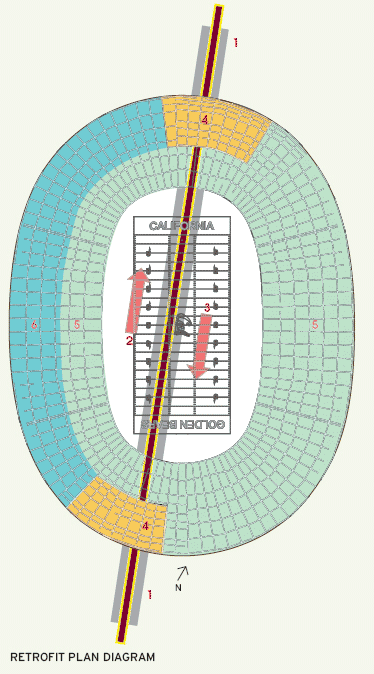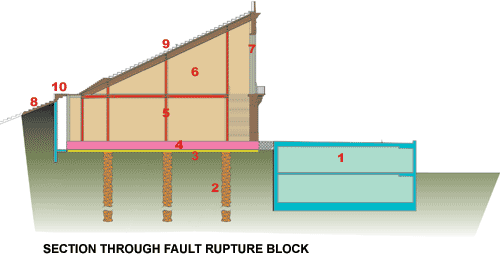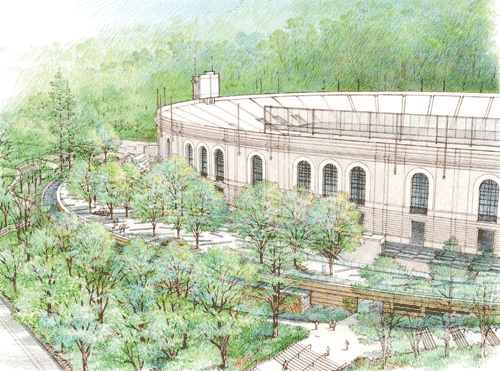Three Buildings, Three Different Approaches
Sliding slowly
Across the bay, at the University of California, Berkeley, engineers are planning a very different kind of retrofit for the school's 85-year-old Memorial Stadium. The engineering problem presented by the stadium is an unusual one, in part because of the building's heritage-it was designed by Beaux-Arts architect John Galen Howard and was placed on the National Register of Historic Places in 2006. But the characteristic that most clearly distinguishes the building from most other structures slated for seismic retrofit is its location straddling the Hayward Fault. The approximately 40-mile-long fault runs along the western edge of the East Bay hills, separating the North American Plate from the Pacific Plate. It bisects the 72,000-seat stadium, tracing a roughly north−south diagonal from one end zone to the other.
Because Berkeley's Memorial Stadium straddles the Hayward Fault (right), it is slated for a retrofit that includes bunkerlike fault rupture blocks (below). 1. Fault line Diagram courtesy Forell/Elsesser |
 |
 |
|||
Diagram courtesy Forell/Elsesser |
Hayward is the type of fault known as "strike-slip." According to geologists, during a quake on this kind of fault, the earth on each side of a ground rupture moves mostly in a horizontal direction, with one plate sliding past the other. Other types of faults, such as "normal" and "reverse" faults, involve primarily vertical movement, while "thrust" faults involve a combination of angled and vertical movement.
 |
Construction of the seismic upgrade will begin after completion of a partially belowground training center. Rendering courtesy HNTB |
A major quake has not occurred along the Hayward fault in 140 years, yet the earth around it is moving very slowly but steadily all the time, at a rate of about 3â„16 inch per year. Evidence of this "fault creep" can be seen in the stadium's nonductal reinforced-concrete structure, especially under the seating bowl at expansion joints, where adjacent columns and beams no longer align. "Incrementally, the eastern half of the building is moving south, and the western half is moving north," explains David Friedman, senior principal with Forell/Elsesser, the stadium project's structural engineer. The San Francisco−based firm has devised a retrofit plan to accommodate expected horizontal surface displacements of as much as 6 feet that could occur during a powerful temblor.
The seismic retrofit is part of a multiphase development plan for the stadium, designed by the Los Angeles office of HNTB Architecture, that includes a new plaza and the partially below-grade Student-Athlete High Performance Center (SHPC) to be built along the western edge of the stadium. The training and sports-medicine facility had been stalled by several lawsuits and protests by local residents opposed to the removal of a grove of trees on the site. But construction of the SHPC is now cleared to move ahead in early 2009. The seismic retrofit project, currently in schematic design, will follow as a second phase.
The goal of Forell/Elsesser's retrofit scheme is to allow the portions of the stadium directly over the fault to move independently from the rest of the building. It includes replacing two wedge-shaped pieces of seating bowl with bunkerlike "rupture blocks" built on top of plastic sheeting and separated from adjacent parts of the structure by a 5-foot gap. During a strong Hayward quake, the blocks may twist or tilt, but occupants will be protected, explains Friedman.
Construction of the blocks will involve several steps. After first reinforcing the stadium's historic perimeter wall, contractors will increase the density of the soil with "rock columns." They will then install the plastic sheet and a 30-inch mat slab before building steel framing and concrete shear walls to support the wedgelike pieces of the seating bowl above. As the final step in the retrofit, workers will reconstruct the upper portion of the western half of the seating bowl. The eastern half, which is built into the Berkeley hillside, along with the part of the seating bowl closest to the field, are slab-on-grade construction. As such, they are not subject to collapse during a temblor, and are therefore not slated for replacement as part of the retrofit project.
Underpinning the scheme is extensive research and collaboration with the university's own experts in fault rupture mechanics, says Friedman. But the solution they developed doesn't rely on high-tech devices such as base isolation or high-damping bearings, he points out. For all its sophistication, "the retrofit involves a fairly conventional use of materials and seismic systems."








